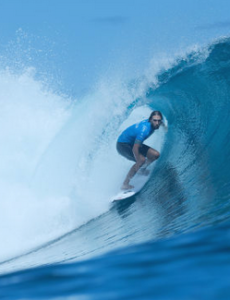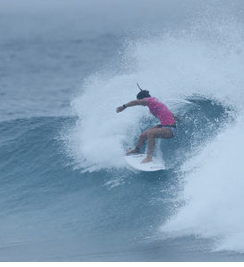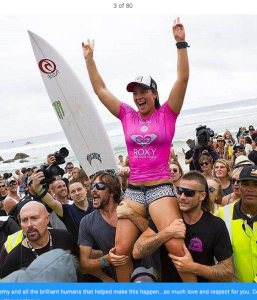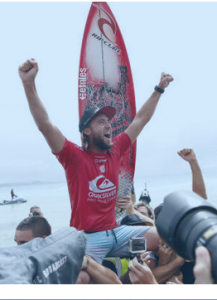24 March 2016
Quicksilver Pro Surf Championships
by Lynda Goetz
 I am English. I do not live on or near the West Cornwall or North Devon coasts and I was 25 a lifetime ago, so it almost goes without saying that my knowledge of surfing is not just minimal but almost non-existent. However, here I am on the Gold Coast and the ‘happening’ event of the moment is the ‘Quiky Pro’ Surf competition, the first of the 2016 WSL (meaning World Surf League in case it’s too early in the morning for you) World Championship season. The people I am staying with have been working on their own technique for the last ten years and an unexpected day off signals the chance to watch the pros doing their stuff just half an hour from home. According to the website, the quarter-finals start at 7.30 am. Yes, I do mean that! Most things start early here, as it gets light by about 4am and dark quite early.
I am English. I do not live on or near the West Cornwall or North Devon coasts and I was 25 a lifetime ago, so it almost goes without saying that my knowledge of surfing is not just minimal but almost non-existent. However, here I am on the Gold Coast and the ‘happening’ event of the moment is the ‘Quiky Pro’ Surf competition, the first of the 2016 WSL (meaning World Surf League in case it’s too early in the morning for you) World Championship season. The people I am staying with have been working on their own technique for the last ten years and an unexpected day off signals the chance to watch the pros doing their stuff just half an hour from home. According to the website, the quarter-finals start at 7.30 am. Yes, I do mean that! Most things start early here, as it gets light by about 4am and dark quite early.
We were not planning on getting there for the start, but headed off south down the M1 Highway around 8.30am. We passed wonderful-sounding places like Mudgeeraba (muj-er-aba) and Worongary that looked rather like UK industrial estates with extra billboards and hoardings, and seemingly randomly numbered exits, which I was advised indicated the number of kilometres from Brisbane. At exit 84 we took the slip road for Coolangatta (a large suburb with a domestic air terminal) and Rainbow Bay, at the end of which lay Snapper Rocks, where the championships were taking place.
 This being the Gold Coast, if not the Sunshine Coast (that’s north of Brisbane), and it not yet being officially Autumn, it had not occurred to me (or my host, who should have perhaps known better) to take a raincoat or an umbrella. Either would have been helpful. As we drove down the M1 the clouds I had happily ignored as we drove off rapidly coalesced, and the raindrops on the windscreen soon became a proper downpour. It was still raining solidly as we parked the car and walked to Snapper Rocks. ‘This,’ I thought as we got increasingly wet walking past children’s playgrounds and confident men swaggering past with surfboards tucked in the approved manner under one arm, ‘is not how it should be’. By the time we reached Snapper Rocks, where an assorted crowd with no particular dress code sat in light rain macs, sodden T-shirts, rash vests and board shorts (with or without umbrellas) on the glistening metamorphic rocks, we too were decidedly soaked. The air was not cold, however, so we gradually acclimatized ourselves to the situation and got on with watching the event.
This being the Gold Coast, if not the Sunshine Coast (that’s north of Brisbane), and it not yet being officially Autumn, it had not occurred to me (or my host, who should have perhaps known better) to take a raincoat or an umbrella. Either would have been helpful. As we drove down the M1 the clouds I had happily ignored as we drove off rapidly coalesced, and the raindrops on the windscreen soon became a proper downpour. It was still raining solidly as we parked the car and walked to Snapper Rocks. ‘This,’ I thought as we got increasingly wet walking past children’s playgrounds and confident men swaggering past with surfboards tucked in the approved manner under one arm, ‘is not how it should be’. By the time we reached Snapper Rocks, where an assorted crowd with no particular dress code sat in light rain macs, sodden T-shirts, rash vests and board shorts (with or without umbrellas) on the glistening metamorphic rocks, we too were decidedly soaked. The air was not cold, however, so we gradually acclimatized ourselves to the situation and got on with watching the event.
To our right the grandstand erected for the VIP guests, the commentary box and the television and other broadcasting media was, in spite of the rather disappointing conditions, heaving with people, but there was still room on the admittedly less than comfortable ridged rocks, although we had to dodge the umbrellas. “Twelve minutes to go in this semi-final and all still to play for,” announced the commentator. We gathered that the participants were Felipe Toledo from Brazil in red (last year’s winner here) and a ‘local’ Aussie, Matt Wilkinson ‘Wilko’ who hailed from New South Wales, in blue. (Apparently it is a very common Aussie thing to shorten, or indeed lengthen, names and add an ‘o’ on the end e.g ‘Wilko’, Johnno’, ‘Davo’.)
The two men seemed to have very different styles. It took me a while to work out that Wilko was ‘goofy’, an expression I knew from my son’s snowboarding, meaning ‘right foot forward’ rather than the more common left. This had him coming down the waves with his back to them, which I would have thought made it more difficult. He clearly did not find it so and executed some impressive ‘backhand surfing’ that earned him some good scores. He got lucky as his opponent fell in front of his board and suffered some sort of injury about halfway through the session. After that fall his wiry, dynamic, elegant style looked a little more tentative, although he was still getting scores in the high sevens.
The scoring, rather as in gymnastics or dancing, is out of 10 and depends on the number of moves or manoeuvres and their execution. Each session is half an hour, although the final has an extra five minutes. The waves seen from the shore did not look enormous, and the greyness and drizzle did not make for dramatic viewing a lot of the time. The fact that many of the waves did not ’stand up’ was clearly a problem, but 10 ‘rides’ in half an hour, as anyone who has tried this frustrating sport knows, is a lot. The more rides you can get, of course, the better chance you have of getting better scores, but the other crucial element is wave selection. The two best scores of each competitor make up their final mark.
In the second semi-final a big score of 8.7 helped Stuart Kennedy, another Aussie, draw into the lead. But his opponent, Kolohe Andino, an American, managed at the last moment to snatch back the victory from the newcomer. So he was going to be the man to face Wilko.
 Before we got to the men’s nail-biting final we were treated to the Roxy women’s final between an American, Courtney Conlogue, and an Australian, Tyler Wright. No less than the men these girls delivered a great spectacle once on the waves, swooping, turning and jumping their way along the walls of water. With impeccable timing they would paddle onto the crest, pull themselves upright and glide across the grey water walls, mostly keeping just ahead of the white surf, but occasionally powering through it following a turn, jump or other manoeuvre. Once the ride was over they were spared the tedium most surfers then have to undergo of paddling their way back to the break point, as they just had to haul themselves and their board onto the back of a specially designed jet ski to be delivered back to the takeoff area. The other enviable aspect of being a competition surfer is that you are only competing with one other person for the right to a wave. For most surfers on the Gold Coast, as in all the good or well-known surfing areas around the world, you will be competing with anywhere between 50 and up to 500 other surfers, all keen to grab a wave. Once you are up and ‘riding’ it is not only bad manners, but of course dangerous, for another surfer to ‘drop in’. To the delight of the crowd, the dark-haired Aussie, Tyler, beat her blonde American opponent who had been the favourite to win.
Before we got to the men’s nail-biting final we were treated to the Roxy women’s final between an American, Courtney Conlogue, and an Australian, Tyler Wright. No less than the men these girls delivered a great spectacle once on the waves, swooping, turning and jumping their way along the walls of water. With impeccable timing they would paddle onto the crest, pull themselves upright and glide across the grey water walls, mostly keeping just ahead of the white surf, but occasionally powering through it following a turn, jump or other manoeuvre. Once the ride was over they were spared the tedium most surfers then have to undergo of paddling their way back to the break point, as they just had to haul themselves and their board onto the back of a specially designed jet ski to be delivered back to the takeoff area. The other enviable aspect of being a competition surfer is that you are only competing with one other person for the right to a wave. For most surfers on the Gold Coast, as in all the good or well-known surfing areas around the world, you will be competing with anywhere between 50 and up to 500 other surfers, all keen to grab a wave. Once you are up and ‘riding’ it is not only bad manners, but of course dangerous, for another surfer to ‘drop in’. To the delight of the crowd, the dark-haired Aussie, Tyler, beat her blonde American opponent who had been the favourite to win.
Next up the mens’ final. I did not realize until much later how fortunate we were to actually be able to watch this. As these events are scheduled over about a fortnight and are totally dependent on wave conditions, which can sometimes change unexpectedly, or as the tide changes, it is not uncommon to anticipate semi-finals and finals only for the whole event to be postposed until later the same day or even the following day or the day after. This is clearly frustrating as a spectator, but must be doubly so for competitors – rather like being a top tennis player at Wimbledon in a rainy July before the new centre court with its roof was created.
 So Wilko, in the red jersey this time, was to face the Californian, Andino, who had ‘been throwing 9s in all his match-ups pretty well all the way up to the final’, and both were in their first final here on the Gold coast. Both had a good ‘air game’ which they perhaps needed to use here. Wilko took a wave first and scored an 8.6. A good start. What had Kolohe Andino to offer? The rain had stopped, the sky was brightening a little, and according to the commentator (who was getting a little harder to hear from where we were as the incoming tide brought the sea and the crashing waves closer to our position on the rocks) there were ‘some good solid waves for this final’. The Californian ‘kept busy’ and took a number of smallish waves that earned him enough points to put him in the lead, but Wilko was just biding his time. According to the giant screen on the beach he needed a 4.3 to get him in the lead. He delivered a score in the fives, putting him in the lead with a total score of 14.20 three minutes before the end. Kolohe Andino needed to pull something out of the bag. He did: a powerful, elegant ride with some impressive turns on waves that were now looking turquoise rather than grey. Could he win this? Wilko was taking no chances; he took another wave and put a lot of energy into executing some exuberant moves. Had he got onto the wave before the final hooter signaled time up? Apparently not. So it was all down to Andino’s last ride. Had he gained enough points to notch his score up above Wilko’s? We all waited. At last the judges’ score came up on the board. A 6.83. Not enough. Wilko had won. The crowd erupted. The competitors paddled for the shore; put an arm around each other to convey congratulations and sympathy before Wilko put his arms in the air in triumph and was borne aloft by his supporters. A home win!
So Wilko, in the red jersey this time, was to face the Californian, Andino, who had ‘been throwing 9s in all his match-ups pretty well all the way up to the final’, and both were in their first final here on the Gold coast. Both had a good ‘air game’ which they perhaps needed to use here. Wilko took a wave first and scored an 8.6. A good start. What had Kolohe Andino to offer? The rain had stopped, the sky was brightening a little, and according to the commentator (who was getting a little harder to hear from where we were as the incoming tide brought the sea and the crashing waves closer to our position on the rocks) there were ‘some good solid waves for this final’. The Californian ‘kept busy’ and took a number of smallish waves that earned him enough points to put him in the lead, but Wilko was just biding his time. According to the giant screen on the beach he needed a 4.3 to get him in the lead. He delivered a score in the fives, putting him in the lead with a total score of 14.20 three minutes before the end. Kolohe Andino needed to pull something out of the bag. He did: a powerful, elegant ride with some impressive turns on waves that were now looking turquoise rather than grey. Could he win this? Wilko was taking no chances; he took another wave and put a lot of energy into executing some exuberant moves. Had he got onto the wave before the final hooter signaled time up? Apparently not. So it was all down to Andino’s last ride. Had he gained enough points to notch his score up above Wilko’s? We all waited. At last the judges’ score came up on the board. A 6.83. Not enough. Wilko had won. The crowd erupted. The competitors paddled for the shore; put an arm around each other to convey congratulations and sympathy before Wilko put his arms in the air in triumph and was borne aloft by his supporters. A home win!
I have to confess that in spite of my initial less-than-wild enthusiasm, I had been won over by the energy and grace of this sport and its evident camaraderie. I had gained an increased appreciation of the difficulty and skill involved. I may in future be watching the videos. I think however I will probably not be taking it up. I suspect one really does need to start very young, be very fit and go out there every day to get to the point where a ride is a graceful, thrilling experience which gives you a real high rather than a frustrating, endlessly disappointing one where you are the loser who never catches the wave or is tossed into the foaming surf and tumbled under the turbulent waters and then hit by your board or someone else’s. I am just waiting for the day when I can sit in my bath chair and plug in somehow to someone else’s brain for the complete virtual experience. I wonder will that be the social media experience? If it is count me in.
Please click here if you would like a weekly email on publication of the Shaw Sheet

